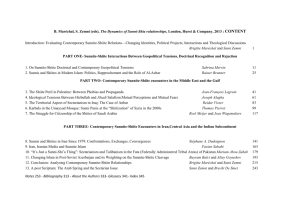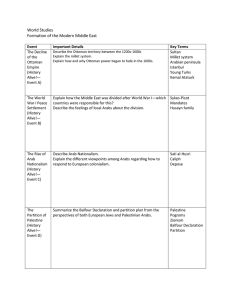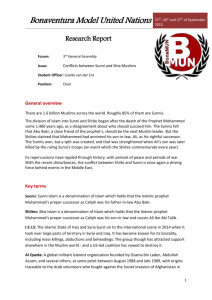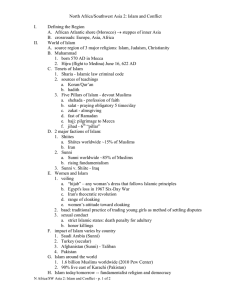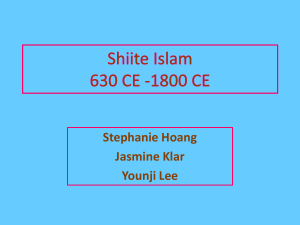I
advertisement
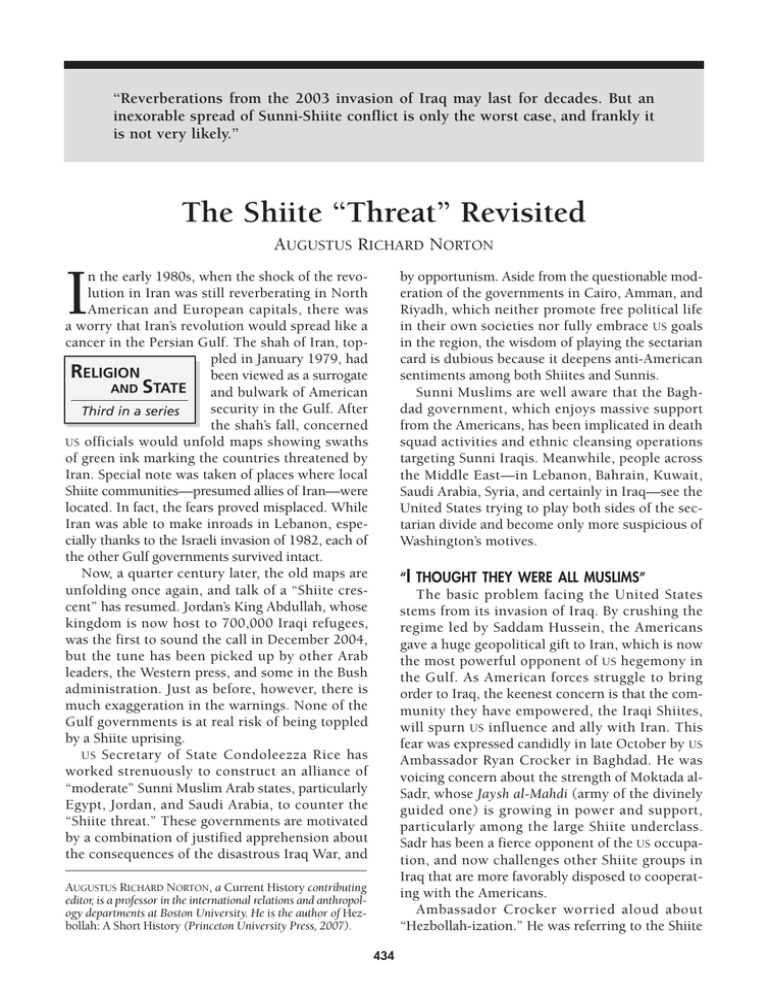
“Reverberations from the 2003 invasion of Iraq may last for decades. But an inexorable spread of Sunni-Shiite conflict is only the worst case, and frankly it is not very likely.” The Shiite “Threat” Revisited Augustus Richard Norton I n the early 1980s, when the shock of the revolution in Iran was still reverberating in North American and European capitals, there was a worry that Iran’s revolution would spread like a cancer in the Persian Gulf. The shah of Iran, toppled in January 1979, had Religion been viewed as a surrogate and State and bulwark of American security in the Gulf. After Third in a series the shah’s fall, concerned us officials would unfold maps showing swaths of green ink marking the countries threatened by Iran. Special note was taken of places where local Shiite communities—presumed allies of Iran—were located. In fact, the fears proved misplaced. While Iran was able to make inroads in Lebanon, especially thanks to the Israeli invasion of 1982, each of the other Gulf governments survived intact. Now, a quarter century later, the old maps are unfolding once again, and talk of a “Shiite crescent” has resumed. Jordan’s King Abdullah, whose kingdom is now host to 700,000 Iraqi refugees, was the first to sound the call in December 2004, but the tune has been picked up by other Arab leaders, the Western press, and some in the Bush administration. Just as before, however, there is much exaggeration in the warnings. None of the Gulf governments is at real risk of being toppled by a Shiite uprising. us Secretary of State Condoleezza Rice has worked strenuously to construct an alliance of “moderate” Sunni Muslim Arab states, particularly Egypt, Jordan, and Saudi Arabia, to counter the “Shiite threat.” These governments are motivated by a combination of justified apprehension about the consequences of the disastrous Iraq War, and by opportunism. Aside from the questionable moderation of the governments in Cairo, Amman, and Riyadh, which neither promote free political life in their own societies nor fully embrace us goals in the region, the wisdom of playing the sectarian card is dubious because it deepens anti-American sentiments among both Shiites and Sunnis. Sunni Muslims are well aware that the Baghdad government, which enjoys massive support from the Americans, has been implicated in death squad activities and ethnic cleansing operations targeting Sunni Iraqis. Meanwhile, people across the Middle East—in Lebanon, Bahrain, Kuwait, Saudi Arabia, Syria, and certainly in Iraq—see the United States trying to play both sides of the sectarian divide and become only more suspicious of Washington’s motives. “I thought they were all muslims” The basic problem facing the United States stems from its invasion of Iraq. By crushing the regime led by Saddam Hussein, the Americans gave a huge geopolitical gift to Iran, which is now the most powerful opponent of us hegemony in the Gulf. As American forces struggle to bring order to Iraq, the keenest concern is that the community they have empowered, the Iraqi Shiites, will spurn us influence and ally with Iran. This fear was expressed candidly in late October by us Ambassador Ryan Crocker in Baghdad. He was voicing concern about the strength of Moktada alSadr, whose Jaysh al-Mahdi (army of the divinely guided one) is growing in power and support, particularly among the large Shiite underclass. Sadr has been a fierce opponent of the us occupation, and now challenges other Shiite groups in Iraq that are more favorably disposed to cooperating with the Americans. Ambassador Crocker worried aloud about “Hezbollah-ization.” He was referring to the Shiite Augustus Richard Norton, a Current History contributing editor, is a professor in the international relations and anthropology departments at Boston University. He is the author of Hezbollah: A Short History (Princeton University Press, 2007). 434 The Shiite “Threat” Revisited • 435 Islamists’ building of social networks through selfThe two smaller Shiite sects are the Ismailis, help groups, businesses, service agencies, and comfound in small numbers in Syria and Iran, and the munity offices, just as Hezbollah (“party of God”) Zaydis, who account for a quarter of Yemen’s popuhad done in Lebanon. Indeed, most of the successlation of 22 million. In the thirteenth century the ful Islamist groups in today’s Middle East have built Ismailis were known as the “Assassins,” but today networks of interlinked units that not only help they are respected, prosperous, and deeply involved their constituents but also reflect values such as in education and ecumenical aesthetic pursuits. empowerment, self-help, and resistance to oppresTheir leader is known as the Aga Khan; they number sion. In addition, like Lebanon’s Hezbollah, Sadr’s only a couple of million adherents worldwide. (The Mahdi Army has benefited from Iran’s largesse. Druze, an offshoot of the Ismailis, number less than It is no exaggeration to say that us leaders were a million and are found in Israel, Syria, and Lebacompletely surprised by some of the challenges non. The Alawites, who rule Syria and comprise 11 that have emerged from the Iraq War. In a remarkpercent of its population, are often considered to able encounter in January 2003, two months before be a Shiite faction as well.) The Zaydis, who ruled the Anglo-American invasion, members of the Iraqi Yemen until 1962, embrace a firm moral code in this opposition were meeting in the Oval Office with life but they reject the mystical religious beliefs usuPresident George W. Bush. Kanan Makiya, an Iraqially associated with Shiism. American academic, began speaking about Sunnis Almost all Shiites believe in the eventual return of and Shiites in Iraq, but Bush interrupted him, puzan imam who will lead the community up to the day zled: “I thought they were all Muslims.” of judgment. The largest Shiite sect, the Twelvers, Bush would not make the same mistake today. traces the descendents of Muhammad to the Twelfth Nonetheless, considerable confusion about the Imam, who disappeared when he went into occultatwo major sects of tion more than a milIslam persists. Senior lennium ago. In the us Homeland Security absence of the Hidden Hezbollah’s rivals fear that its ultimate aim officials, for instance, Imam, these believers is to transform Lebanon into an Islamic state. have been documented seek guidance from identifying Al Qaeda as respected and spea Shiite group; it is in cially educated clerics, fact dogmatically anti-Shiite. In Capitol Hill hearsuch as Ayatollah Muhammad Hussein Fadlallah of ings, congressmen are on record using “Palestinian” Lebanon, or Ayatollah Ali Sistani in Najaf, Iraq—by as a synonym for Shiite, though there are almost no far the world’s most influential Shiite cleric. In conPalestinian Shiites. trast, religious authority in the majority Sunni sect is much more diffuse. The heirs of ali While Iraq and Iran may come quickly to mind In all, there are thought to be about 1.3 billion when the topic of Shiism is introduced, Shiites are Muslims in the world, and as many as 15 percent found in significant numbers in six other Middle of them are members of some branch of Shiism. Eastern countries, as well as outside the region. By There are three major Shiite sects, but they all far, the largest concentration of Shiites is in Iran, share a special regard for the House of the Prophet where they comprise 90 percent of the country’s Muhammad and the belief that the Prophet’s 70 million inhabitants; followed by Iraq, where 60 spiritual guidance was transmitted by divine percent of the population of 27 million are Shiites. ordination through his descendents, especially There are about 1.3 million in Lebanon. Not countthrough his son-in-law and cousin Ali. (The Suning guest workers, about 2 million Shiite citizens nis believed caliphs did not need to be descended are distributed among Bahrain, Kuwait, Qatar, Saudi from the Prophet.) For Shiite Muslims, the holy Arabia, and the United Arab Emirates. day Ashura commemorates the martyrdom of one Except for Bahrain, where they account for Imam Hussein—the grandson of the Prophet and 70 percent of the half-million citizens (another son of Ali—whose demise in the seventh century, 250,000 expatriate workers live on the island), near the city of Karbala in modern-day Iraq, has in the other Gulf states the Shiites represent only become a lodestone of modern identity for Shia small fraction of the total population (ranging ites, much as the crucifixion of Jesus is central to from 5 to 8 percent in Saudi Arabia to 25 percent Christian identity. in Kuwait). In fact, some of the largest popula- 436 • CURRENT HISTORY • December 2007 tions of Shiites are found outside the Gulf and the Middle East. There are locally significant populations in Indonesia, perhaps 6 million in Azerbaijan, approximately 10 million in India, and at least 30 million in Pakistan. hostile to Shiism. Yet it was the self-styled “Islamic Revolution” in predominantly Shiite Iran that offered the most profound critique of the secular state in the Middle East. If Ayatollah Ruhollah Khomeini and his corevolutionaries were disappointed by the Sunnis’ The fluidity of identity reluctance to embrace their revolution and its Popular authors such as the historian Bernard idiosyncratic religio-political structure, the exemLewis promote the view that sectarian identity is a plar of a state informed by Islam was still powerpermanent, historically rooted quality that lies at ful. In Egypt, a few Sunnis were so inspired by the heart of Middle Eastern politics. Lewis has also the revolution that they converted to Shiism, but popularized the view that a longing for the lost their very small numbers underline the limited glory of the past lies at the heart of Muslim hostilappeal of Iran’s model to Sunnis. The most enthuity to the West and to the United States in particusiastic Sunni embrace of the “Islamic Revolution” lar. These can be very self-satisfying perspectives came in Lebanon, where Iran founded Hezbolfor Western readers because they offer a simple forlah in the early 1980s, taking advantage of the mula for understanding Middle East politics, and opportunity created by Israel’s 1982 invasion and they absolve external powers from responsibility the long Israeli occupation of southern Lebanon, for political problems in the region. which ended only in 2000. A mere century or so ago, sectarian affiliation There were a few half-hearted attempts to imiwas neither a particularly important marker of tate the Iranian example. In Bahrain, an amateurfaith nor an important ish coup was thwarted basis for political action. in 1981. In the same In recent decades, before period, Kuwait suffered People across the Middle East the present fever of secseveral acts of terrorism see the United States trying to play tarianism infected the emanating from its Shiboth sides of the sectarian divide. region, there were actually ite community. Bursts several initiatives toward of militancy erupted taqarub (rapprochement) among minority Shiites between Sunnis and Shiites. While these ecumeniin Saudi Arabia’s Eastern province, but these did cal impulses were not successful, they hint that not last long. Since then, particularly in the past assuming an unbridgeable gulf between the sects decade, the Saudi government has taken some is a contemporary prejudice. steps to lift controls on the public practice of ShiAlthough the differentiation of the Shiite and ism and has afforded the Shiite community modSunni sects dates to the earliest days of Islam, the est levels of representation at the national level. political salience of sectarian identity has varied Considering that the dominant Saudi religious dramatically over the course of history, not to group is the puritan Wahhabis, who consider mention in recent decades. For instance, in Iraq Shiism to be anathema, it was a milestone when and Lebanon well into the 1960s, Shiite Muslims Saudi Arabia’s King Abdullah received Sadr, the were politically mobilized very successfully by the Iraqi Shiite cleric, near the holy city of Mecca. Communist party. Arab Sunnis and Shiites alike In Iraq, the Baathist regime turned the screws of were widely attracted to the ideology of Nasserrepression on Shiites and, in 1980, opportunistiism in the 1950s and 1960s. In Bahrain, where the cally launched what would be an eight-year war to sparks of Sunni-Shiite tension have ignited several contain the Iranian revolution (with clear support recent clashes, the Shiites were fervent admirers from the United States as well as Sunni-dominated of Egyptian President Gamal Abdel Nasser just a countries, including Saudi Arabia and Kuwait). few decades ago. When that war finally ended in 1988 it was Iran By the 1970s in the Arab world, heretofore domthat tasted defeat. Iraq’s immense Shiite populainant secular-nationalist ideologies began to be tion, which comprised much of the rank and file in energetically challenged by Sunni Islamist groups, the army, had proved deaf to Iran’s clarion. which offered both a critique of the secular state Nonetheless, hints of the sectarian passions that and a call for activism informed by a renewal of would later brutally affect Iraqi politics were visible piety. In some instances, these groups were overtly in the spring of 1991. Heeding President George H. The Shiite “Threat” Revisited • 437 W. Bush’s call for an uprising to topple Hussein, whose army had just been expelled from Kuwait, many of Iraq’s Shiite Muslims joined an intifada against the regime. Iraq’s army unleashed a furious and pitiless response. Iraqi Shiites begged at the Kuwait border for sanctuary, where the us military stood watch. American soldiers might as well have been spectators in Rome’s Coliseum. The supplicants were rebuffed and turned back to their wretched fates. No state in the region lifted a finger to help the victims, except Iran, and Iran did nothing to stanch the bloodshed. An estimated 100,000 Iraqi Shiites were killed. Incredibly, this horrendous moment made so little impression on American war planners in 2003 that the invading us forces did not anticipate the lingering suspicion and contempt that often greeted them among the Iraqi Shiites. Academic experts in some cases only added to the public’s ignorance by pandering to or promoting stereotypes. Johns Hopkins University’s Fouad Ajami, who was then testifying before Congress on Islamic radicalism, offered the now famous aphorism: “The Sunnis are homicidal and the Shiites are suicidal.” Suicide, he said, “is definitely a Shiite phenomenon because of the ethic of martyrdom and martyrology which is exalted in the Shiite experience and which knows no equivalent in Sunni life.” As quotidian examples from Palestine and Israel, Iraq, Afghanistan, Chechnya, and a handful of other locales demonstrate, Ajami’s insight does not stand up to the evidence. Sunni Muslims have proved adept at transforming themselves into human bombs at great cost to innocent victims, not least on September 11, 2001. Religious sect, just as any other form of ascriptive identity, such as race or ethnicity, may be used to rationalize a horrifying variety of outrages against those who are different. Abu Musab al-Zarqawi, the late and savage leader of Al Qaeda in Iraq, certainly understood the divisive potential of sectarian affinity. In 2004 he wrote: “If we succeed in dragging [the Shiites] into the arena of sectarian war, it will become possible to awaken the inattentive Sunnis as they feel imminent danger.” Before he died at us hands, Zarqawi ordered numerous suicide attacks against Shiite targets, thereby helping to push Iraq’s Sunnis and Shiites into a civil war. The case of lebanon Lebanon already has fought a civil war along sectarian lines, a war that lasted 15 years, ending only in 1990. Today that country is locked in a tense stalemate that Lebanese fear might end with the eruption of a new civil war. Sectarian passions are inflamed for several reasons: the assassination of former Prime Minister Rafik Hariri in 2005; the 34-day war with Israel in 2006 that brought ruin to Lebanon’s economy and destruction to many parts of the country; and the manipulations and encouragement of numerous outside players, including the United States, a variety of European states, Iran, Syria, Israel, Saudi Arabia, and some other Middle Eastern nations. Lebanon has also been cursed with a weak central government and a set of self-interested sectarian leaders who often treat the state as a feeding trough. The 2006 war started when Hezbollah’s paramilitary wing provoked Israel by capturing two Israeli soldiers from Israeli territory, thereby breaking the “rules of the game” that defined the security system in southern Lebanon. The United States encouraged and supported Israel’s summer war to disable if not destroy Iran-supported Hezbollah. Israel failed and Hezbollah emerged from the war more or less intact, but surrounded by ruins in southern Lebanon and in the Beirut suburbs where many Shiite supporters of Hezbollah live. The us-backed government in Beirut is now in a fierce test of wills with an opposition that includes not only Shiites, but also many Christians and a number of other Lebanese supporting Hezbollah. While the wider Arab world celebrated Hezbollah’s “victory” in the war, closer to home many questioned the party’s motives and the war’s consequences, which included an estimated $4 billion to $5 billion in reconstruction costs and a heavy toll in lives and personal property. Politically, the war divided Lebanon in two. One Lebanon is a coalition of mainly Sunnis, Druze, and Christians who came together after Hariri’s assassination. This group, demanding the truth about Hariri’s killers and a withdrawal of Syrian forces from Lebanon, mobilized as many as a million protesters in downtown Beirut. After winning the parliamentary elections in May 2005, this coalition was in power during the 2006 war. It accuses Hezbollah of instigating the disastrous war with Israel, and of being an agent of Syria and Iran. The second Lebanon is also a coalition, consisting mostly of the southern Lebanese Shiite community and large elements of the Christian community—especially the followers of the magnetic Maronite Christian politician and former 438 • CURRENT HISTORY • December 2007 general Michel Aoun. The “Aounists” and Shiites legality, given Lahoud’s refusal to agree to it, the share a profound sense of victimization in the face tribunal was approved by the Security Council in of what they see as a corrupt and unresponsive May 2007. The tribunal now is a sword of Damopolitical system. cles that swings over the heads of the opposition. The slow pace of government payments to those Meanwhile, seven prominent figures have been who lost their homes thanks to Israel’s relentless assassinated since 2005. All of the victims are bombing is widely viewed as an example of official opponents of Syrian influence in Lebanon; the ineffectiveness, much in contrast to Hezbollah’s most recent was killed in a car bombing in Septemspeedy distribution of $12,000 payments to each ber 2007. The result is a climate of fear among profamily made homeless by the war. The opposition government politicians. The political stakes were alliance has proved remarkably durable. Most basiraised on December 1, 2006, when opposition supcally, it is trying to expand its share of power at the porters erected 1,000 tents in Beirut’s Riyadh alexpense of the traditional Christian elite and the Sulh and Martyr’s Square, literally at the feet of the Sunni Muslims. Indeed, it is the threat of a decline government, and announced that they would not in Sunni prerogatives and power in Lebanon that budge until the government succumbed. Massive has prompted Saudi Arabia to become a key backer numbers of people assembled on the first day of of the government. the demonstration, immobilizing the commercial In Western circles, Hezbollah and the Aounists heart of Beirut. are perceived as trying to protect Syria by stifling As tensions continued to rise, fighting erupted efforts to authorize an international tribunal to in January 2007 between Sunni gunmen and Shiite try those accused protesters. Four peoof responsibility for ple were killed. But the killing of Hariri Hezbollah at this point None of the Gulf governments is at real and his associates. stepped back from the risk of being toppled by a Shiite uprising. (The Syrian regime is brink. Appearing on widely suspected of television, Nasrallah having directed the declared that “anyassassination.) There is some truth in the charge, one using a firearm against a Lebanese brother since a weakening of Syria would no doubt is working for Israel.” The situation calmed. It weaken its friends in Lebanon. helped that the Lebanese army during this period performed with both neutrality and firmness. Back from the brink Since early 2007 neither side has budged much The fall of 2006 was marked by an escalation politically from its position. of tension and demands, including an ultimatum While the stalemate has been enormously costly by Hezbollah leader Hasan Nasrallah on October to Lebanon’s economy, and while the continuing risk 31 demanding that the government either agree to of a new civil war is obvious, the demonstrations are a national unity government or face widespread now restrained and usually peaceful. Initially tens demonstrations and other forms of organized presof thousands of opposition supporters occupied the sure such as blockades on the route to the national tents, but today the tents often stand empty, quiet airport. In conjunction with these demands, all canvas testaments to the frozen political situation. five Shiite members of the government resigned in In all, 10 deaths may be attributed to the demonNovember. The opposition then noted that, under strations, which have been under way for a year. a 1989 agreement, every major sect must be repAt the same time, however, extremist Sunni resented in government. President Emile Lahoud groups, some inspired by Al Qaeda, have proliferasserted that the government was no longer legitiated in Lebanon. These groups are generally hostile mate (vis-à-vis the question of an international trito Shiites. In May 2007, clashes broke out in the bune, notably). Nahr al-Bared Palestinian refugee camp in northTo block a vote on the tribunal, Speaker Nabih ern Lebanon. It took the lightly equipped LebaBerri refused to convene parliament. But in an endnese army four months to defeat the Sunni group, run around the opposition, Prime Minister Fouad at the cost of more than 160 dead soldiers and the Siniora requested action by the United Nations displacement of more than 34,000 civilians. The Security Council to mandate an international triurgency of the crisis was further demonstrated in bunal. While Siniora’s request was of doubtful June, when six soldiers from Colombia and Spain The Shiite “Threat” Revisited • 439 serving in the un mission were killed in the south, following calls by Al Qaeda’s number two leader, Ayman al-Zawahiri, for Muslims to confront the “Crusaders,” meaning the international soldiers. The attacks led to quiet security contacts between un officials and Hezbollah, prompting Zawahiri to pointedly criticize Hezbollah. Hezbollah’s rivals fear that its ultimate aim is to transform Lebanon into an Islamic state and that the party is only feigning attachment to Lebanon as a pluralist society. But Nasrallah and his colleagues have claimed frequently that the conditions for establishing a state based on Islamic rule will probably never exist in Lebanon, since such a state could only be established on the basis of broad consent, which is highly unlikely. Whatever dreams Hezbollah might entertain, the conclusion that there will never be widespread support for an Islamic state is a sound one. A less fractious future? In his commendably lucid book, The Shia Revival: How Conflicts within Islam Will Shape the Future, Vali Nasr emphasizes—in my view overstates—enduring Sunni-Shiite tensions in history. But his argument largely turns on the importance of the mayhem in Iraq as a historical watershed. In the past, social and political conventions kept sectarian distrust and enmity hidden from view. With Iraqi society in chaos and the fate of the state uncertain, the veneers are stripped away, exposing the deep-grained realities. But even if this holds for Iraq, which some respected scholars doubt, it is deceptive to generalize from the Iraqi case. The invasion destroyed the already dry-rotted institutions of a dictatorship, imposed an incompetent occupation on Iraq, empowered a disenfranchised majority, and did so in country where civil society had been obliterated for years. Fortunately, this would be a hard case to replicate. Even so, the invasion and its aftermath effectively lent validation to Al Qaeda’s ideology, and have inspired some anti-Shiite Sunnis to open Al Qaeda “franchises” in places far removed from Iraq. There have been other dubious “accomplishments” as a result of the war. When Hussein was hanged at the end of 2006, he won posthumous fame as a Sunni hero. An Egyptian weekly published a commemorative edition that included a poster depicting the late dictator and captioned: “He lived heroically and died a man.” These developments have had variant impacts in societies where Sunnis and Shiites live side by side. In prosperous Kuwait, the Shiites participate in government, and the Shiite community is defined by several distinct orientations, ranging from secularism and quietism to radicalism. Some Kuwaiti Shiites follow the late and moderate Ayatollah Muhammad Shirazi; others support the Iranian regime; still others adhere to Arab religious authorities, such as Iraq’s Sistani. While relations among the sects in Kuwait are generally good, the Salafis (Sunnis who favor a return to an earlier, “purer” form of Islam) are usually hostile to the Shiites. In March 2007, a Kuwaiti Sunni cleric named Uthman al-Khamis announced plans to launch “Tibah” (disclosure), a new satellite channel to warn Muslims of “the Shiite threat.” In Bahrain, where Shiites comprise 70 percent of the population but have suffered considerable discrimination by the government, Lebanon’s Hezbollah is extremely popular. Bahrain, though tiny in population, is strategically important to the United States. The Fifth Fleet is headquartered in Bahrain and many us Navy vessels are replenished and repaired there. A growing number of Bahrainis are expressing opposition to the American role in their country, and one can expect this opposition to grow. In fact, Hezbollah’s al-Manar satellite station is the most popular source of news in the monarchy. Bahrain is the poorest of the small Arab Gulf states, and many of its disadvantaged Shiites are a rapt audience for Nasrallah. In Manama, the capital, at least three stores sell a variety of Hezbollah literature, dvds, tee shirts, and decorations. The Bahraini Shiites, moreover, boast a proud and long history of political and economic protests. The minority regime is firmly in place in Bahrain, but much will depend on how wisely it responds to inevitable calls for reform. Throughout the Middle East, reverberations from the 2003 invasion of Iraq may last for decades. But an inexorable spread of Sunni-Shiite conflict is only the worst case, and frankly it is not very likely. One hopes imaginative political leaders will pursue enlightened and conciliatory policies. A spirit of conciliation is implied, for instance, in a recent observation by King Abdullah of Saudi Arabia: “If sectarianism deepens and spreads, its destructive effect will reflect on everyone. It will foster division, polarization, and isolationism. Our region will drown in a conflict whose outcome cannot be foreseen.” Equally important, if leaders in North America, Europe, and Asia are able to escape the conceptual prisons they have built for themselves, a less fractious future is possible. ■


